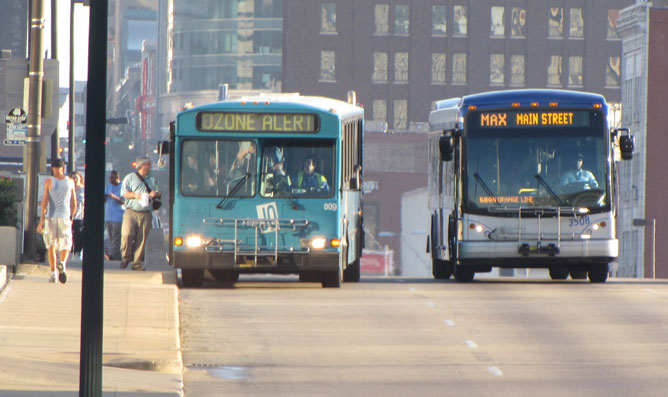
“With this new grant, we’ll be able to explore ways to expand transit to connect more people to job opportunities, especially in high-growth employment centers in suburban areas,” said Ron Achelpohl, MARC’s director of transportation.
The Kansas City region will receive a $1.2 million planning grant for an initiative to double the number of jobs accessible by public transit over the next 10 years. The award is one of 72 grants totaling $600 million announced Sept. 12 by the U.S. Department of Transportation as part of its 2014 TIGER (Transportation Investment Generating Economic Recovery) grant program.
The Mid-America Regional Council applied for the grant on behalf of the Regional Transit Coordinating Council, in partnership with the area’s four transit agencies — the Kansas City Area Transportation Authority, Johnson County Transit, Unified Government Transit and Indebus.
“The employment rate is up and more companies are hiring, but there is often a disconnect between where people live and where the jobs are,” said Ron Achelpohl, MARC’s director of transportation. “Our public transit system currently offers little suburb-to-suburb service, and we want to identify ways to address that.”
A recent study by the Brookings Institution found that only 18 percent of jobs in the region are reachable via transit in 90 minutes or less — ranking the Kansas City region 90th of the 100 largest metros.
The “KC Workforce Connex” initiative will build on work completed over the past four years with grants from an earlier round of TIGER funding and a Sustainable Communities regional planning grant from the U.S. Department of Housing and Urban Development.
“We’ve developed a centers-and-corridors framework for transportation improvements, focusing on key corridors that branch out from the central business district,” said Achelpohl. “With this new grant, we’ll be able to explore ways to expand transit to connect more people to job opportunities, especially in high-growth employment centers in suburban areas.”
Grant partners will use a four-part strategy to strengthen transit connections between people and jobs.
- Identify high-priority areas where improvements will have the most impact.
- Expand the region’s existing corridor framework, connecting to more suburban employment centers.
- Engage employers and community organizations in planning through extensive public engagement and outreach.
- Use technical tools to evaluate specific strategies and recommendations in targeted, high-impact areas.
With this round of TIGER funding, the U.S. DOT gave priority to investments that will connect communities to centers of employment, education, and services, and that hold promise to stimulate long-term job growth. “We’re creating ladders of opportunity for the middle-class and those seeking to enter the middle-class by investing in transit,” said Secretary Foxx.
The KC Workforce Connex planning initiative is expected to begin in 2015 and take 18 months to complete.